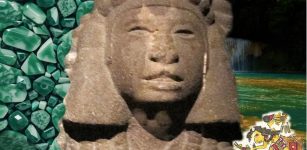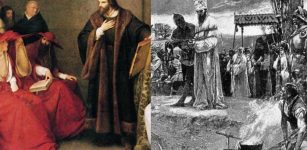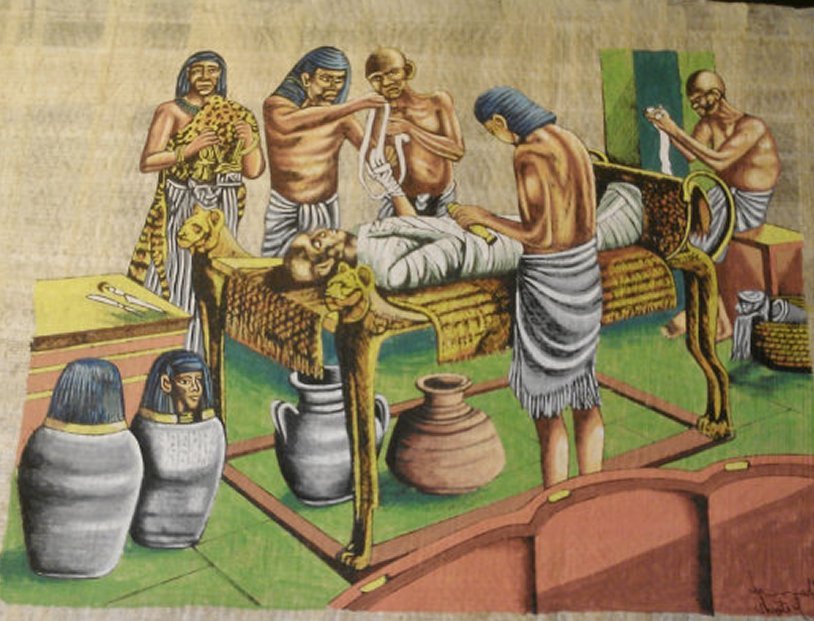Unique Chinchorro Burial Tradition For All And Ancient Egyptians Who Mummified Kings And Nobles Only
A. Sutherland - AncientPages.com - Mummies have long fascinated the world. Mummification is the great ancient tradition and has been a worldwide practice for over 7,000 years.
How were the first techniques of mummification discovered?
The internal organs were removed through the incision and then cleaned, dried, wrapped and placed in four canopic jars. Image via History In An Hour
Millennia ago, in the Middle East, the head were separated from the rest of the dead body and facial features of the dead were modeled on the skull.
It was not mummification as we know it today from archaeological evidence but it was a desire to preserve the human remains and facial features.
Over the centuries, numerous beliefs and funeral practices in many cultures were combined to preserve the posthumous existence of the dead.
In his book "The Golden Branch," James George Fraser wrote that in many cultures, there was no doubt that the aging of the body and its postmortem decay can harmfully affect the soul that inhabits it. It was therefore necessary to prevent changes that could lead to the death of the soul.
The Chinchorro culture that lived on the coast of present day northern Chile and southern Peru, created the earliest known mummies.
A Chinchorro mummy - at San Miguel de Azapa Museum in Arica, Chile; Arica is often referred to as the driest place on Earth, but locals say that is changing. Photograph: Vivien Standen/Washington Post
They preserved all their dead using elaborate techniques. The dead remained with the living and symbolized as the link between the dead and the living.
Recent research indicates that the tradition of embalming in Egypt is much older than previously thought and can match the age of Chinchorro culture.
The Egyptians constantly refined their mummification process, and by the New Kingdom period, they had perfected their techniques, so even today Roman Catholic Church follows them when preserving the bodies of deceased popes.
See also:
Mystery Of The Chinchorro Civilization And The World’s Oldest Mummies
Canopic Jars: Funerary Tradition Of Ancient Egyptians And Their Beliefs In Afterlife
Viking Burial Rituals: High Ancient Funeral Pyre Reflected High Social Status
To the ancient Egyptians, death was the next step in a great process of continuation of life – afterlife. But to participate in it, the body had to be properly preserved.
The Egyptians were wrapping their dead in linen as early as c.3400 BC, with linen impregnated with resin or sometimes with plaster to preserve the contours of the body. Around 2600 BC, they began to remove the internal organs (except for the kidneys) to prevent decomposition. The brain, which was never preserved, was removed through the nose with an instrument that looked like a hooked metal rod.
For the next three millennia, the Egyptians refined and perfected their techniques and by New Kingdom times, about 1570-1070 BC, they became the world’s most skilled and famous practitioners of mummification.
It was long believed that the Chinchorro people of Chile preserved bodies before the Egyptians. First, now researchers have been able to analyze ancient Egyptian graves at Mostagedda, Badari and Hierakonpolis and the results indicate that buried bodies were subjected to embalming treatments before being deposited in the grave.
Dating of these burials to the fifth millennium BC makes them the contemporaries of the Chinchorro mummy of South America.
However, the Chinchorro burial practices were unique in many ways.
Bernardo Arriaza, an expert on the mummies, which were first discovered in the Atacama desert in 1917, wrote that “…whereas the Egyptians considered only kings and other exalted citizens worthy of mummification, the Chinchorro accorded everyone in the community, regardless of age or status, this sacred rite…”.
Without pottery farming and literacy, the Chinchorro people were considered as primitive, but interestingly, they possessed complex mummification techniques that confirm they were a highly sophisticated culture.
From c.6000 BC, the Chinchorro began to 'rebuild' their dead, with bodies carefully removed flesh and the skin, brain and internal organs removed. The bones were dried with hot ashes before the whole lot was then reassembled using twigs for reinforcement bound tightly with reeds.
Finally, a layer of ash paste was applied over the body, a clay mask used to cover the face and a wig made of human hair was placed on the head.
At first, only infants and children, decorated with vibrant colors and diverse clay figurines. At its peak around 3000 BC, Chinchorro mummified men, women, and children of all ages and in the final days of this culture, the mummies bore only mud masks. The mummies were apparently not buried but were stood upright in a visible location in the camp, perhaps to indicate the group’s lineage from a common ancestor.
In addition, not all members of Chinchorro bands were mummified; some were buried in simple graves. Such graves have been found on elevated terraces and containing one or more individuals who may have been family groups.
Written by – A. Sutherland AncientPages.com Staff Writer
Copyright © AncientPages.com All rights reserved. This material may not be published, broadcast, rewritten or redistributed in whole or part without the express written permission of AncientPages.com
Expand for referencesReferences:
Andrews C. Egyptian Mummies: Revised Edition
Stein R. L. Stein P. Anthropology of Religion, Magic, and Witchcraft
Sciencing - In Ancient Egypt, What Did They Put in a Mummy's Stomach?
More From Ancient Pages
-
 Babylonians And Sumerians Had Advanced Knowledge Of Astronomy
Civilizations | Feb 28, 2017
Babylonians And Sumerians Had Advanced Knowledge Of Astronomy
Civilizations | Feb 28, 2017 -
 On This Day In History: Treaty Of Picquigny – Negotiations Between England And France – On Aug 29, 1475
News | Aug 29, 2017
On This Day In History: Treaty Of Picquigny – Negotiations Between England And France – On Aug 29, 1475
News | Aug 29, 2017 -
 Lagina Sanctuary Of Goddess Hekate: Archaeologists Found Ceremonial ‘Sacred Road’
Archaeology | Jul 10, 2019
Lagina Sanctuary Of Goddess Hekate: Archaeologists Found Ceremonial ‘Sacred Road’
Archaeology | Jul 10, 2019 -
 Amazing Restoration Of Ancient Roman Vineyard Buried Underneath The Ash Of Mount Vesuvius For 2,000 Years
Archaeology | Nov 27, 2020
Amazing Restoration Of Ancient Roman Vineyard Buried Underneath The Ash Of Mount Vesuvius For 2,000 Years
Archaeology | Nov 27, 2020 -
 Colossi Of Memnon: Gigantic Stone Statues Guarding The Temple Of Pharaoh Amenhotep III
Civilizations | Jul 13, 2016
Colossi Of Memnon: Gigantic Stone Statues Guarding The Temple Of Pharaoh Amenhotep III
Civilizations | Jul 13, 2016 -
 Ancient Scandinavians Never Spoke Of Themselves As Vikings – Here Is Why
Ancient History Facts | Mar 15, 2021
Ancient Scandinavians Never Spoke Of Themselves As Vikings – Here Is Why
Ancient History Facts | Mar 15, 2021 -
 Riddle Of The Hanging Gardens Of Babylon – Highly Advanced Technologies – Part 2
Featured Stories | Jun 11, 2019
Riddle Of The Hanging Gardens Of Babylon – Highly Advanced Technologies – Part 2
Featured Stories | Jun 11, 2019 -
 Mysterious ‘Temple Of The Crossed Hands’ Of Kotosh – One Of The Oldest Structures In Peru
Featured Stories | Mar 15, 2023
Mysterious ‘Temple Of The Crossed Hands’ Of Kotosh – One Of The Oldest Structures In Peru
Featured Stories | Mar 15, 2023 -
 Chalchihuitlicue: Beautiful, Dangerous, Changeable And Unpredictable Water Goddess In Aztec Mythology
Featured Stories | Mar 20, 2024
Chalchihuitlicue: Beautiful, Dangerous, Changeable And Unpredictable Water Goddess In Aztec Mythology
Featured Stories | Mar 20, 2024 -
 New Clues Why Neanderthals Visited La Cotte de St Brelade In Jersey 250,000 Years Ago
Archaeology | Jun 18, 2023
New Clues Why Neanderthals Visited La Cotte de St Brelade In Jersey 250,000 Years Ago
Archaeology | Jun 18, 2023 -
 When Did Humans Start Using Roads And What Civilization Built The First Paved Roads?
Archaeology | Oct 26, 2022
When Did Humans Start Using Roads And What Civilization Built The First Paved Roads?
Archaeology | Oct 26, 2022 -
 On This Day In History: Adventurer Thor Heyerdahl And His Kon-Tiki Reached French Polynesia – On August 7, 1947
News | Aug 7, 2016
On This Day In History: Adventurer Thor Heyerdahl And His Kon-Tiki Reached French Polynesia – On August 7, 1947
News | Aug 7, 2016 -
 Extraordinary Etruscan And Roman Treasure Trove Unearthed In San Casciano dei Bagni, Italy
Archaeology | Aug 12, 2022
Extraordinary Etruscan And Roman Treasure Trove Unearthed In San Casciano dei Bagni, Italy
Archaeology | Aug 12, 2022 -
 Jan Hus: Czech Reformer And Bohemian Religious Leader Was Burned At Stake For Heresy
Featured Stories | Dec 17, 2019
Jan Hus: Czech Reformer And Bohemian Religious Leader Was Burned At Stake For Heresy
Featured Stories | Dec 17, 2019 -
 Was Ancient Egyptian Science Inherited From A Lost Atlantean Civilization?
Civilizations | Sep 4, 2017
Was Ancient Egyptian Science Inherited From A Lost Atlantean Civilization?
Civilizations | Sep 4, 2017 -
 Crosby-Schøyen Codex: Ancient Coptic Manuscript Reveals Sermon That Spurred Violence Against Jews
Featured Stories | Jun 5, 2024
Crosby-Schøyen Codex: Ancient Coptic Manuscript Reveals Sermon That Spurred Violence Against Jews
Featured Stories | Jun 5, 2024 -
 Ancient DNA And Tombstones Lead Scientists To Black Death’s Source Strain
Archaeology | Jun 15, 2022
Ancient DNA And Tombstones Lead Scientists To Black Death’s Source Strain
Archaeology | Jun 15, 2022 -
 Mystery Of The Candelabrum: One Of The Most Enigmatic Ancient Giant Ground Drawings In The World
Featured Stories | Nov 2, 2015
Mystery Of The Candelabrum: One Of The Most Enigmatic Ancient Giant Ground Drawings In The World
Featured Stories | Nov 2, 2015 -
 Polycarp Of Smyrna: Burned At The Stake And Pierced With A Dagger
Featured Stories | Jun 25, 2020
Polycarp Of Smyrna: Burned At The Stake And Pierced With A Dagger
Featured Stories | Jun 25, 2020 -
 Raijin: Shinto God Of Thunder And Lightning With Three Fingers Representing Past, Present And Future
Featured Stories | Feb 10, 2020
Raijin: Shinto God Of Thunder And Lightning With Three Fingers Representing Past, Present And Future
Featured Stories | Feb 10, 2020




